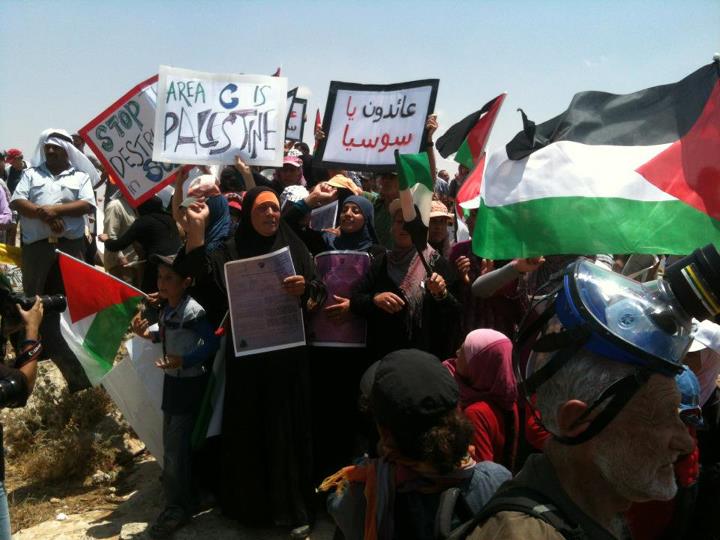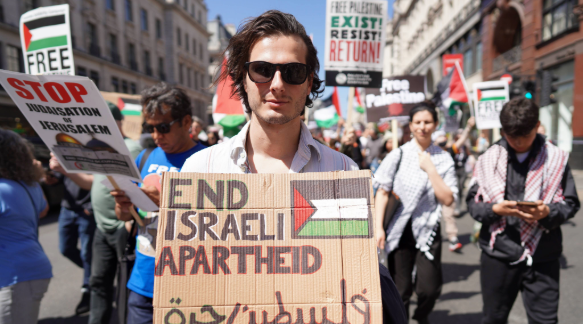The Demographic Armageddon is being constantly re-scheduled and the numbers themselves frequently undergo strange and inscrutable changes.
Frequent publications on the Palestinian demographic “time bomb” threatening to destroy the Jewish majority in the Land of Israel are causing Israeli policy-makers to go into hysterics and argue that withdrawal from Judaea and Samaria is in Israel’s interest • But when one follows the publications, which originate in the Palestinian Authority, it turns out that the Demographic Armageddon is being constantly re-scheduled and that the numbers themselves frequently undergo strange and inscrutable changes • Yaakov Feitelson, who has analyzed Palestinian demography for two decades, exposes the truth behind the myth of the “Palestinian womb”

One of the regular rituals of the Israeli-Palestinian conflict are the Palestinian announcements that within such-and-such amount of time the Palestinians will become a majority in the Land of Israel west of the Jordan. These announcements receive considerable attention in Israel and abroad and are now an inseparable part of the factors shaping Israeli policy. Estimates of other Arab researchers such as the Egyptian researcher Bissan Jehad Edwan, who already in 2004 identified the demographic time-bomb as an “Arab self-delusion” receive far less, if any, attention.
Since the history of Palestinian demography derives from the official publications of the Palestinian Central Bureau of Statistics (PCBS), it is worthwhile to take a look at the Bureau’s forecasts made over the years in its annual population estimates. The findings are very surprising: not one of the PCBS’s forecasts has panned out, and the target date of the demographic disaster has been put off again and again.
A Chronicle of Contradictory Statements
Thus, in an announcement made on February 14, 2005, Prof. Yousef Ibrahim of Al-Aqsa University in the Gaza Strip argued that Israel has already lost the demographic battle and that in 2010 the Land of Israel would contain 6.3 million Arabs as against 5.7 million Jews. In the wake of this announcement, The Atlantic published an article with the heading “Will Israel Live to 100?”
Less than two years later, the PCBS already had to update this forecast, stating in 2006 that “the [demographic] equality of 5.7 million [Jews and Arabs] is expected by the end of 2010” – a reduction of six hundred thousand people since the 2005 announcement, and an unclear postponement of the Palestinian dream of demographic equality.
When 2010 finally came, the forecast was updated yet again: on December 29, 2010, an announcement was made with the heading: “PCBS: An Arab majority in historic Palestine after 2014.” According to this, the Arab population in Judaea, Samaria and the Gaza strip (JSG) will reach 6.1 million in 2014, making it equal to the Jewish population; not only was the date of demographic upheaval once again made later than the original announcement in 2005, the numbers themselves were reduced: it turned out that even in 2014, the number of Arabs would be 200,000 people lower than even the forecast for 2010.
The farce continues until today: towards the end of 2012, the PCBS published that the sum total of Arabs in the Land of Israel numbered 5.8 million as opposed to 6 million Jews. According to the updated forecast, the Arab population would reach equality with the Jews in 2016 when it would number 6.5 million people, even reaching 6.6 million in 2017. From then on, the Jews would be a minority. Within just seven years, from 2005 onward, the Palestinians changed their date of demographic victory no less than four times, with frequent and odd changes of the population numbers involved.

Imaginary Increase
The latest forecast is also not free of problems. First, the expected rates of expected demographic growth contradict each other: according to this forecast the Arab population will increase by 800,000 people in five years by 2017, or an average of 160,000 people per year for an average annual increase of 2.61%. Except that according to the same figures, it turns out that the Arab population of 2017 will only increase by 100,000 in 2016 – a growth rate of 1.54%, or almost half of what is supposed to occur over the five-year period. It’s not clear what is supposed to cause this change in rate of increase.
Whatever the Palestinian increase rates actually are, a check of actual (as opposed to projected) figures shows a far lower rate of increase: a cross-check of the Israeli CBS figures for Israeli Arabs and the Palestinian CBS’s published figures for Arabs in the entire Land of Israel reveals that a total of 4,151,400 Arabs live in JSG. A simple calculation shows that the Arab population in these areas grew by only 42,769 people from 2010 to 2012, an average of around 21,386 per year. That’s an annual increase of 0.5%, less than a fifth of the PCBS projected increase according to their forecast for 2017.
This calculation is reinforced by checking the World Bank figures for the Arabs living in JSG: in the three-year period of 2008-2011 this population increased by only 82,118 for an annual increase of 27,373. Considering that the Israeli Arab population grew an average of 37,100 people annually between 2010 and 2012, the total annual growth of Arabs in the Land of Israel comes to 58,600 – a little more than a third of the PCBS’s forecasted increase. It’s worth mentioning that in this same period the Jewish population grew by more than 212,000 – an annual average of 106,000 and almost twice the Arab growth rate.

So How Many Palestinians are there?
To check the real growth of the Arab population in JSG, we will use the data made available by the Israeli and Palestinian Central Bureaus of Statistics as well as UN demographic estimates, examine the differences among these estimates and explain the reasons for them.
The Israeli CBS began publishing demographic data on Judaea, Samaria and Gaza in 1967 when it conducted the first population census. The numbers were published in Israeli Statistical Annuals until 1993 for Gaza and 1994 for Judaea and Samaria. According to these, the Arab population in these areas was 966,700, growing to 1,599,700 by 1990. According to the advisor to the UN Conference on Trade and Development, Dr. Wael R. Ennab of An-Najah University in Nablus, the Arab population in Judaea and Samaria numbered 933,577 and the Gaza Strip 625,391 for a total of 1,558,968 – 40,000 people less than the ICBS figures.
In Ennab’s opinion, the discrepancy between the ICBS’ estimates and his own can be explained by the under-reporting of Arab deaths to the authorities. Ennab explains this phenomenon as the unwillingness of the Arab population to cooperate with surveys conducted by the Israeli authorities. Thus, he writes, some two thirds of deaths in Judaea and Samaria were not reported to the authorities. Ennab is right of course, but in my opinion there is an additional and more fundamental reason for the under-reporting of Arab deaths: because international aid to Palestinians is given according to the number of residents, many of these prefer not to report deaths and continue to collect money meant for the deceased.
If so, according to the ICBS data for 1967-1990, the Arab population in JSG, not including East Jerusalem, grew by 65.5% in 23 years for an average annual growth rate of 2.22%. If this rate had continued unchanged for the next twenty years, then this same population could have reached 2,573,703 by 2010 or 1,534,928 people less than the PCBS’ population forecast for that year. If the rate had remained constant for another seven years, then the Arab population in JSG would have reached only 2,965,210 by 2017. When you add to this the Israeli Arab population, which based on their 2012 growth rate will reach only around 1.82 million people this year, it turns out that the Arab population in the whole of the Land of Israel will reach around 4.8 million people – 1.8 million less than the Palestinian forecast.
Assuming the expanded Jewish population continues to grow at the same rate as 2012, that is 1.72% annually, it may reach 6,897,000 by 2017 – 66.1% of the population of the Land of Israel without the Gaza Strip and 58.9% of the overall population of the Land of Israel west of the Jordan.

The Trend: Downward
However, the growth rate of the Arab population has not remained constant over time, being affected by two major factors: a sharp drop in natural increase and emigration from JSG. The emigration of Arab youth from JSG is causing an additional drop in natural increase, as one can see from the existing trend in the overall fertility rate. In fact, it is reasonable to assume that in the wake of this emigration, the annual growth of the Arab population will drop even faster. The continuing decline in Arab birth rates, the emigration of many Arab youth abroad as well as the maturing and aging of the Arab population which will lead to an increase in mortality in time, will cause an even greater decline in the Arab population’s growth rate in the years to come. As a result, the number of Arabs in the Land of Israel may drastically drop from 2030 onward.
As the demographer Prof. Justin McCarthy wrote back in the day: “Those who have dealt with estimates concerning the Palestinian population greatly exaggerated or minimized the numbers in line with the political intentions of the estimators themselves. This must be taken into account when statistical data on the Palestinians is presented…all data connected to the Palestinian populace are only estimates.”
Yaakov Feitelson is the author of “Demographic Trends in the Land of Israel (1800-2007)”, Institute of Zionist Studies 2008. This article is based on a version of the article updated for 2013; a detailed analysis of the data can be found among the IZS’ list of publications.
To receive updates on new articles in English, join Mida on Facebook or Twitter.





